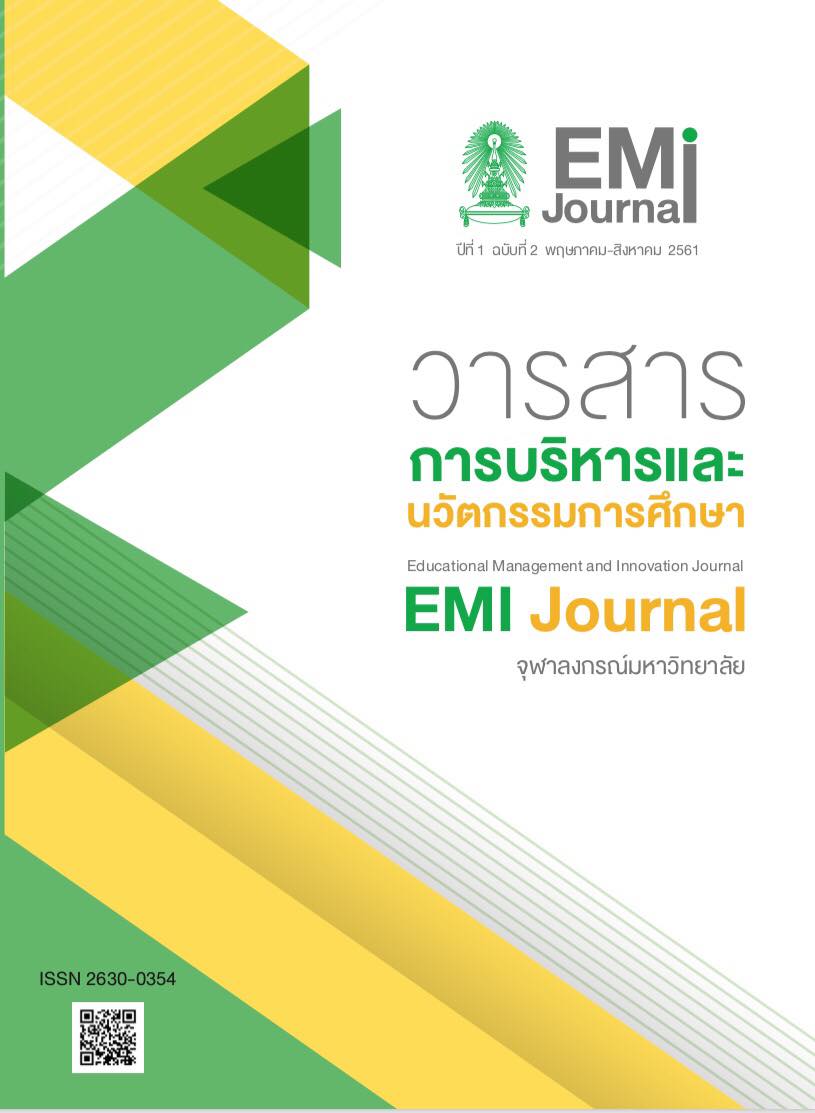การบริหารสถานศึกษาขั้นพื้นฐานเพื่อพัฒนาทักษะการคิดเชิงนวัตกรรมของครู; THE BASIC EDUCATION SCHOOL MANAGEMENT FOR DEVELOPING TEACHER’S INNOVATIVE THINKING SKILLS
คำสำคัญ:
การบริหารสถานศึกษา, นวัตกรรม, ทักษะการคิด, ทักษะการคิดเชิงนวัตกรรม, School Management, Innovation, Thinking skills, Innovative thinking skillsบทคัดย่อ
การวิจัยครั้งนี้มีวัตถุประสงค์เพื่อ 1) ศึกษากรอบแนวคิดทักษะการคิดเชิงนวัตกรรม และการบริหารสถานศึกษาขั้นพื้นฐานเพื่อพัฒนาทักษะการคิดเชิงนวัตกรรมของครู และ 2) ศึกษาสภาพการบริหารสถานศึกษาขั้นพื้นฐานเพื่อพัฒนาทักษะการคิดเชิงนวัตกรรมของครู วิธีดำเนินการวิจัยประกอบด้วย ขั้นตอนที่ 1 ศึกษาเอกสารและงานวิจัยที่เกี่ยวข้องกับทักษะการคิดเชิงนวัตกรรมของครูและการบริหารสถานศึกษาขั้นพื้นฐานเพื่อพัฒนาทักษะการคิดเชิงนวัตกรรมของครู ขั้นตอนที่ 2 ศึกษาทักษะการคิดเชิงนวัตกรรมของครูและสภาพการบริหารสถานศึกษาขั้นพื้นฐานเพื่อพัฒนาทักษะการคิดเชิงนวัตกรรมของครู โดยเก็บข้อมูลจากตัวแทนครูที่สังกัดสำนักงานเขตพื้นที่การศึกษาประถมศึกษา จำนวน 340 คน โดยใช้สถิติค่าเฉลี่ยและค่าเบี่ยงเบนมาตรฐาน ผลการวิจัยพบว่า 1) กรอบแนวคิดทักษะการคิดเชิงนวัตกรรมของครู ประกอบด้วย (1) ทักษะ การตั้งคำถาม (2) ทักษะการสังเกต (3) ทักษะการทดลอง (4) ทักษะการสร้างเครือข่าย (5) ทักษะการเชื่อมโยง และกรอบแนวคิดการบริหารสถานศึกษาขั้นพื้นฐานเพื่อพัฒนาทักษะการคิดเชิงนวัตกรรมของครู ประกอบด้วย (1) การสร้างวิสัยทัศน์และกลยุทธ์เชิงนวัตกรรม (2) การกำหนดโครงสร้างการบริหารสถานศึกษา (3) ระบบของสถานศึกษาที่ก่อให้เกิดการคิดเชิงนวัตกรรม (4) รูปแบบของภาวะผู้นำเชิงนวัตกรรม (5) การบริหารจัดการทรัพยากรบุคคล (6) ค่านิยมร่วมของสถานศึกษา (7) ทักษะการบริหารองค์กรนวัตกรรม 2) ผลการศึกษาทักษะการคิดเชิงนวัตกรรมของครูในภาพรวมทั้ง 5 ทักษะ อยู่ในระดับมาก ทักษะการตั้งคำถามมีผลการประเมินสูงสุด รองลงมาคือ ทักษะการเชื่อมโยง ส่วนทักษะ
ที่มีผลการประเมินต่ำสุดคือ ทักษะการสร้างเครือข่าย และผลการศึกษาสภาพการบริหารสถานศึกษาขั้นพื้นฐานเพื่อพัฒนาทักษะการคิดเชิงนวัตกรรมของครู ด้านการบริหารอยู่ในระดับมาก โดยมีการนำระบบเทคโนโลยีทางการศึกษามาใช้ในการพัฒนานวัตกรรมอย่างต่อเนื่องมีผลการประเมินสูงสุด รองลงมาคือ ส่งเสริมให้บุคลากรคิดค้นนวัตกรรมมาใช้ในการพัฒนาการศึกษาอย่างต่อเนื่อง ส่วนประเด็น ที่มีผลการประเมินต่ำสุดคือ การนำระบบเครือข่ายมาใช้ในการแลกเปลี่ยนเรียนรู้ข้อมูลเชิงนวัตกรรม
THE BASIC EDUCATION SCHOOL MANAGEMENT FOR DEVELOPING TEACHER’S INNOVATIVE THINKING SKILLS
The objectives of this research were to 1) study conceptual framework of teacher’s innovative thinking skills and 2) study the basic education school management for developing teachers’ innovative thinking skills. The research consists of 2 steps. Step 1: review the literature and research related to teachers’ innovative thinking skills and the basic education school management for developing teachers’ innovative thinking skills.
Step 2: study the basic education school management for developing teachers’ innovative thinking skills using questionnaires from 340 teachers. Data were analyzed, using mean and standard deviation.
The research results found that 1) the framework of the teachers’ innovative thinking skills were communication skills, observation skills, questioning skills, experimental skills, networking skills, collaborative skills. The framework of Basic Educational Institution management to develop teachers’ innovation thinking skills were (1) formulating vision and innovative strategies (2) structure of school management (3) systems of school to promote teachers’ innovative thinking skills (4) style of innovative leadership (5) personnel
management (6) shared values and (7) innovative organizational management skills 2) the results of the overall teachers’ innovative thinking skills were at a high level. Questioning skills was the highest, followed by collaborative skills. The lowest was the networking skills. Management conditions for developing innovative thinking skills of teachers in basic education schools was at a high level. The continuous use of educational technology in the development of innovation was at the highest level. Secondly, to encourages innovation to be used in continuously education development. The lowest mean fell on introduction of networking to be used in innovative information sharing.
Downloads
เอกสารอ้างอิง
ชัยณรงค์ วงศ์ธีรทรัพย์. (2557). ถอดรหัสแนวคิด เพื่อชีวิตที่มีคุณค่า. กรุงเทพมหานคร : อมรินทร์พริ้นติ้ง แอนด์พับลิชชิ่ง.
ดิเรก พรสีมา. (2559). ครู 4.0.มติชน. ฉบับวันที่ 4 พ.ย. 2559.
ธีระ รุญเจริญ. (2553). ความเป็นมืออาชีพในการจัดและบริหารการศึกษายุคปฏิรูปการศึกษาเพื่อปฎิรูปรอบ 2 และประเมินภายนอกรอบ 3. กรุงเทพมหานคร : ข้าวฟ่าง.
ไพฑูรย์ สินลารัตน์. (2557). คิดนอกกรอบ : สอนและสร้างได้อย่างไร. กรุงเทพมหานคร : วิทยาลัยครุศาสตร์
มหาวิทยาลัยธุรกิจบัณฑิตย์.
วชิน อ่อนอ้าย, ฉันทนา จันทร์บรรจง, วิทยา จันทร์ศิลา และสำราญ มีแจ้ง. (2558). รูปแบบการโรงเรียนเอกชนสู่ความเป็นองค์กรนวัตกรรม. วารสารศึกษาศาสตร์มหาวิทยาลัยนเรศวร, 17(2), 74-84.
วิจารณ์ พานิช. (2555). การศึกษาไทย 2552-2553 สู่เส้นทางแห่งอาจารย์บูชา “ครูเพื่อศิษย์”. กรุงเทพมหานคร : สถาบันส่งเสริมการจัดการเรียนรู้เพื่อสังคม.
สุกัญญา แช่มช้อย. (2555). แนวคิดเชิงนวัตกรรมสำหรับการบริหารสถานศึกษาในศตวรรษที่ 21. วารสารศึกษาศาสตร์ มหาวิทยาลัยนเรศวร, 14(2), 117-128.
สุพรรณี อาวรณ์ และแก้วเวียง นำนาผล. (2557). การพัฒนาครูในการจัดการเรียนรู้ด้านการคิดวิเคราะห์โรงเรียนผาน้ำทิพย์วิทยา สำนักงานเขตพื้นที่การศึกษามัธยมศึกษา เขต 27. วารสารบัณฑิตวิทยาลัยพิชญทรรศน์, 9(2), 71-80.
สำนักงานเลขาธิการสภาการศึกษา. (2552). รายงานการวิจัยสภาพปัญหาและแนวทางแก้ปัญหาการจัดการเรียนการสอนที่ส่งผลต่อการพัฒนาคุณภาพผู้เรียนในระดับการศึกษาขั้นพื้นฐาน. กรุงเทพมหานคร : วี.ที.ซี. คอมพิวนิเคชั่น.
อรชร ปราจันทร์ และสุกัญญา แช่มช้อย. (2561). รูปแบบการบริหารเพื่อพัฒนาทักษะการคิดเชิงนวัตกรรมของครู ในสถานศึกษาขั้นพื้นฐาน. วารสารวิชาการมหาวิทยาลัยฟาร์อีสเทอร์น, 12(1), 156-169.
Adair, J. E. (1996). Effective innovation: how to stay ahead of the competition. London: Pan Books.
B.ness Roberta. (2012). Tools for Innovative thinking in Epidemiology. American Journal of Epidemiology, (March), 16(175), No. 8.
Christisnsen, J. A. (2000). Building The Innovative Organization. Hampshire: Macmillan Press.
Global Creativity Corporation. (2007). Understanding and applying innovation styles for insight. San Francisco, CA: Author.
Higgins, James M. (1995). Innovate or evaporate: Test and improve your organization’s IQ – Its innovation quotient. New Management.
Hoidn, S., & Karkkaunen, K. (2014). Promoting skill for innovation in higher education: A literature review on the effectiveness of problem-based leaning and of teaching behaviors. N.P.: OECD Education Working Paper.
Holder, Bob J. and Matter, Gary. (2008). The innovativeorganization. from http://www.geocities.com/CollegePark/Library/1048/innova.html
Horth, D. (2014). How to use innovation to lead effectively work collaboratively, and drive results. N.P.: Center for Creative Leadership and Dan Buncher, Continum.
IBSA. (2009). Developing innovation skills. Australia: Department of Education, Employment and workplace Relations.
Jiménez-Jiménez, D., & Sanz-Valle, R. (2005). Innovation and human resource management fit: An empirical study. International Journal of Manpower, 25(4), 364-381.
Li, Zhao, & Liu. (2006). The relationship between HRM, technology innovation and performance in China. International Journal of Manpower, 25, 4.
Miller, W. C., Couger, J. D., & Higgins, L. F. (1989). Person: innovation styles profile of IS personnel VS other occupation. Creative Innovation Management, 5(4), 226-233.
Peter, T. J. & Waterman, R. (1982). Insearch of excellence. New York: Harper & Row.
Safko, L. S. (2007). The three Cs innovative thinking. N.P.: Financial Time.
S. K. Lee and Benza. (2015). Teaching Innovtion skill: Application of design Thinking in Graduate Marketing Course. Business Education Innovation Journal, (June 2015), 43-49.
Sherwood, L. (2001). Fisiologi manusia: Dari Sel ke Sistem (2nd ed.). N.P.: Jakarta.
Swallow Erica. (2012). Can Innovative Thinking Be Learned. Forbes, Appril 19.
Tidd, Joe, Bessant, Jonh and Pavitt, Keitk. (2001). Mananging innovation Integrating Technological market and organization change. Chichester: John Wiley & Sons.
Von Stamm, B. (2008). Managing innovation, desige and creativity. Chichester: John Wiley & Sons.
Yamane, T. (1973). Statistics: An introductory analysis (3rd ed.). New York: Harper and Row.



